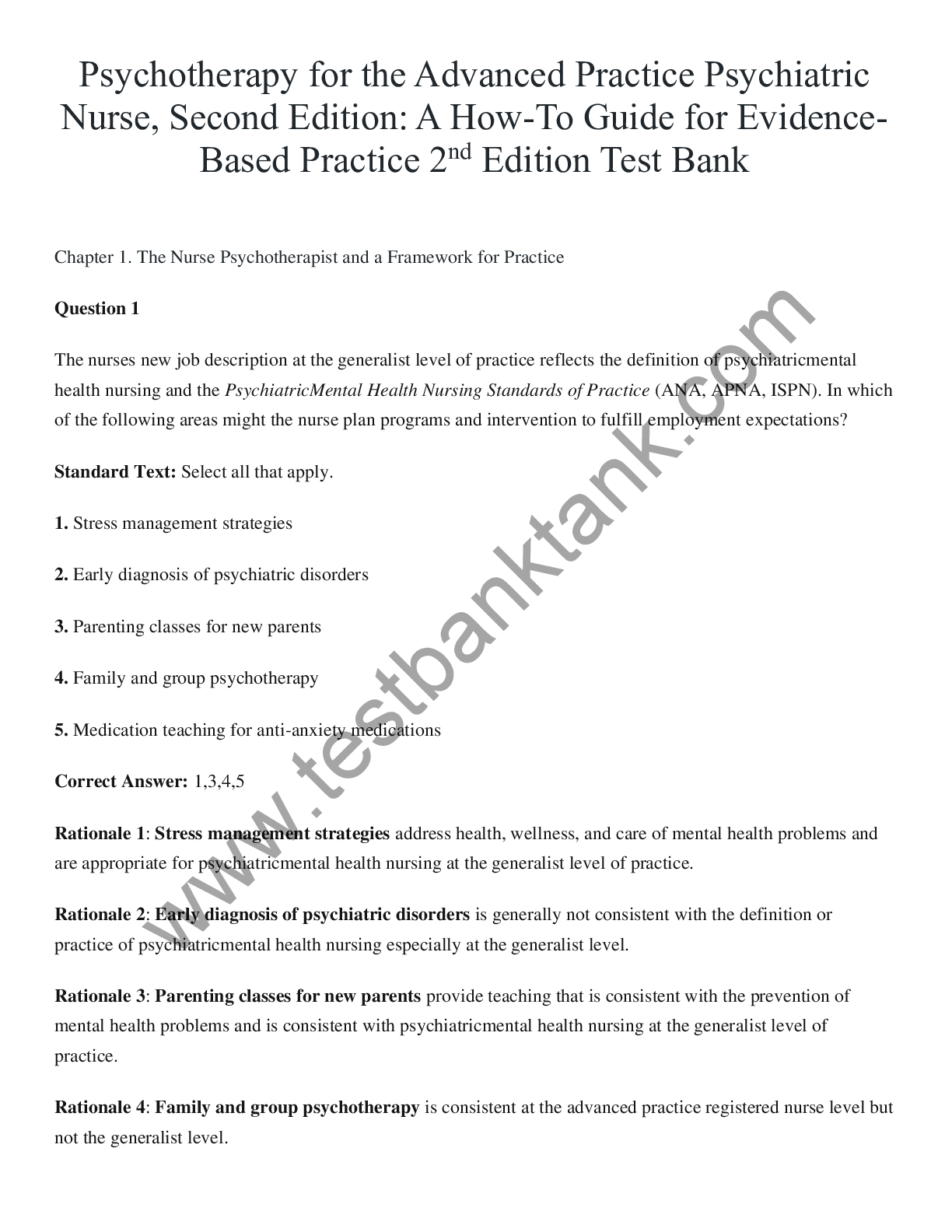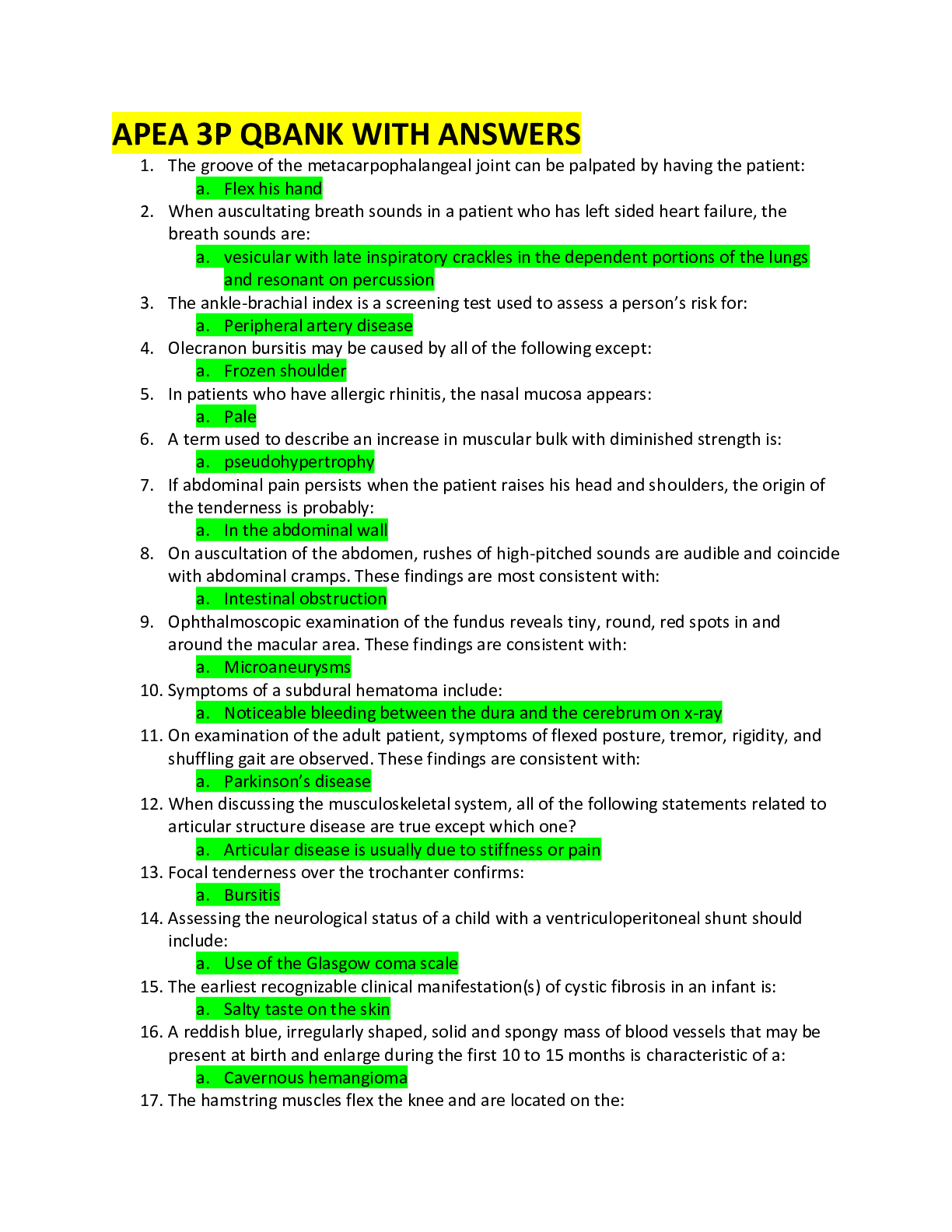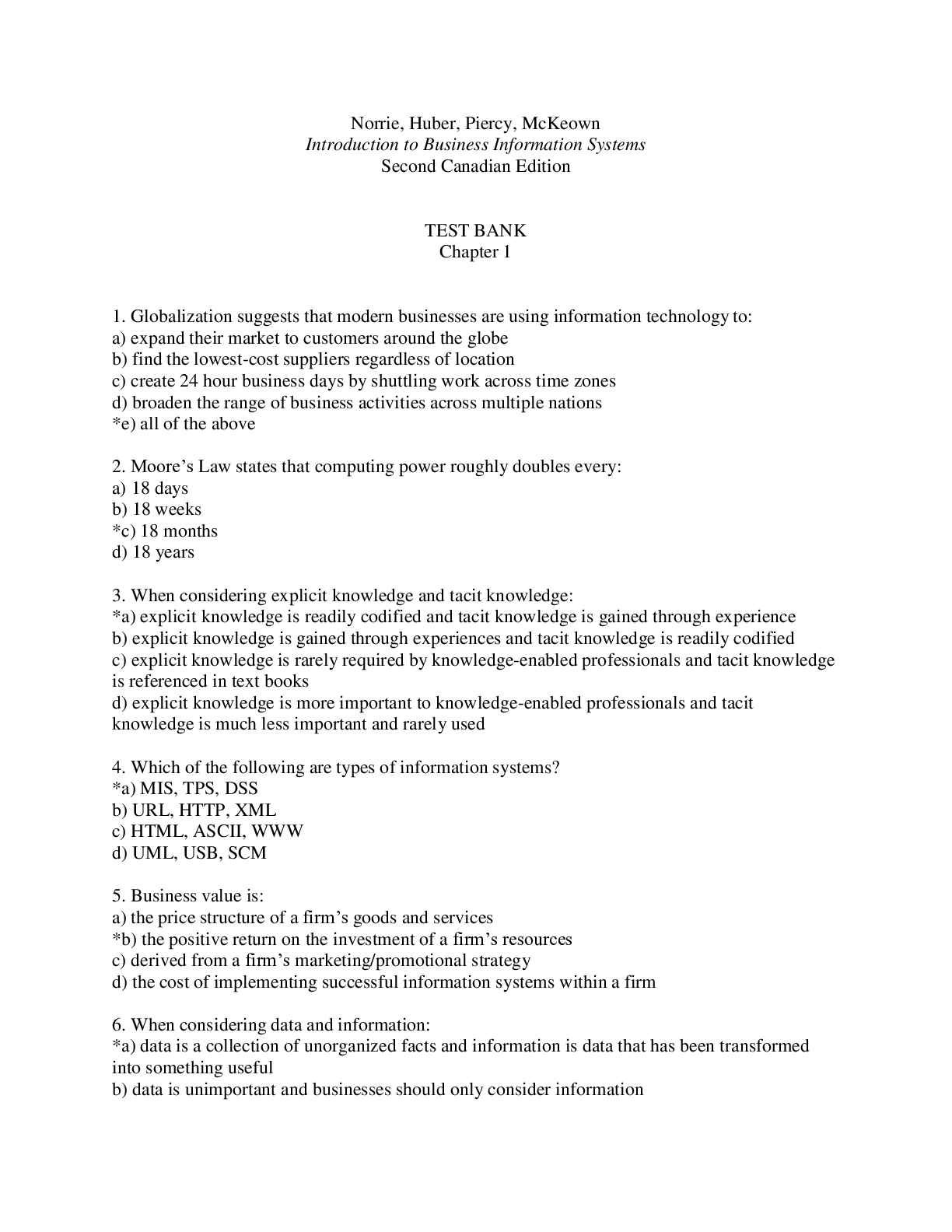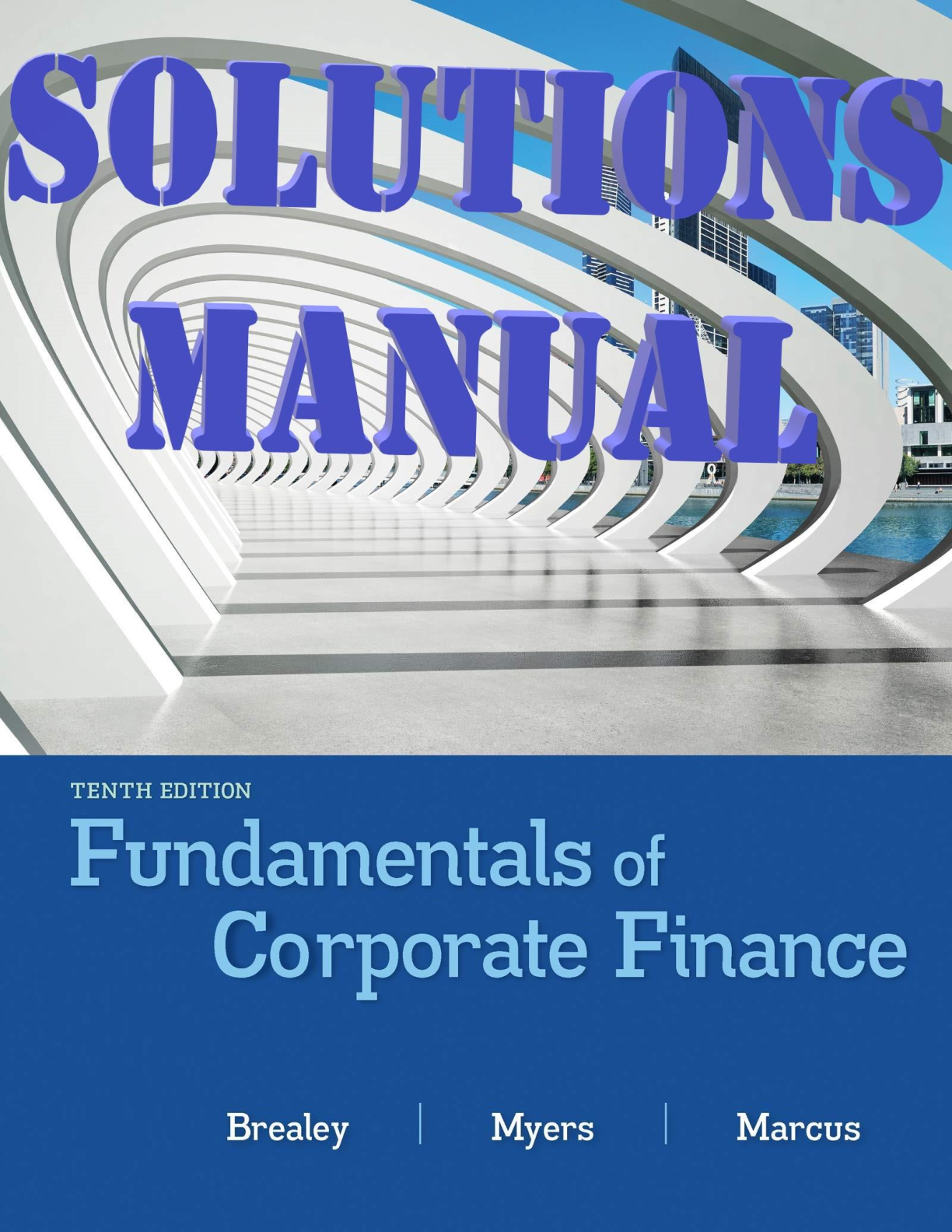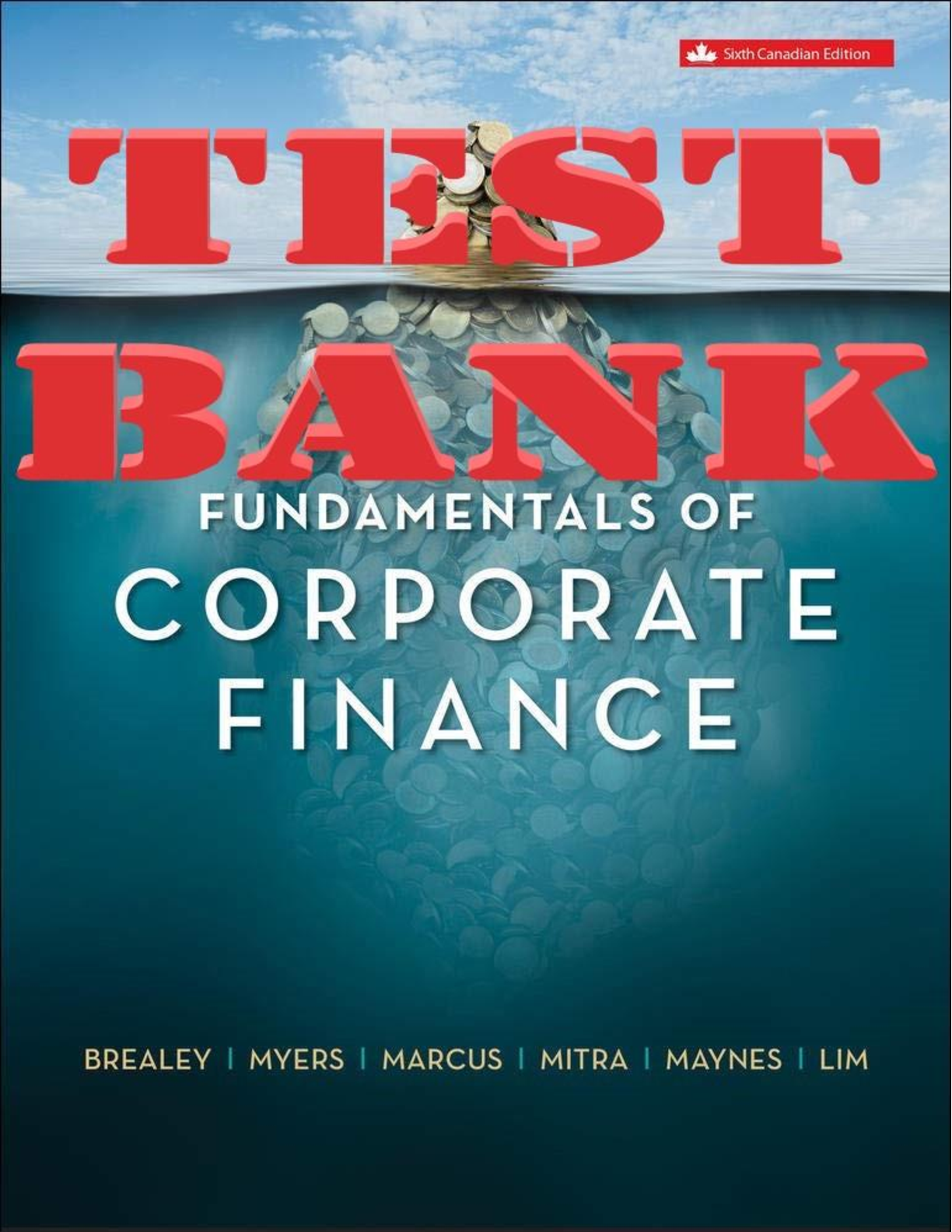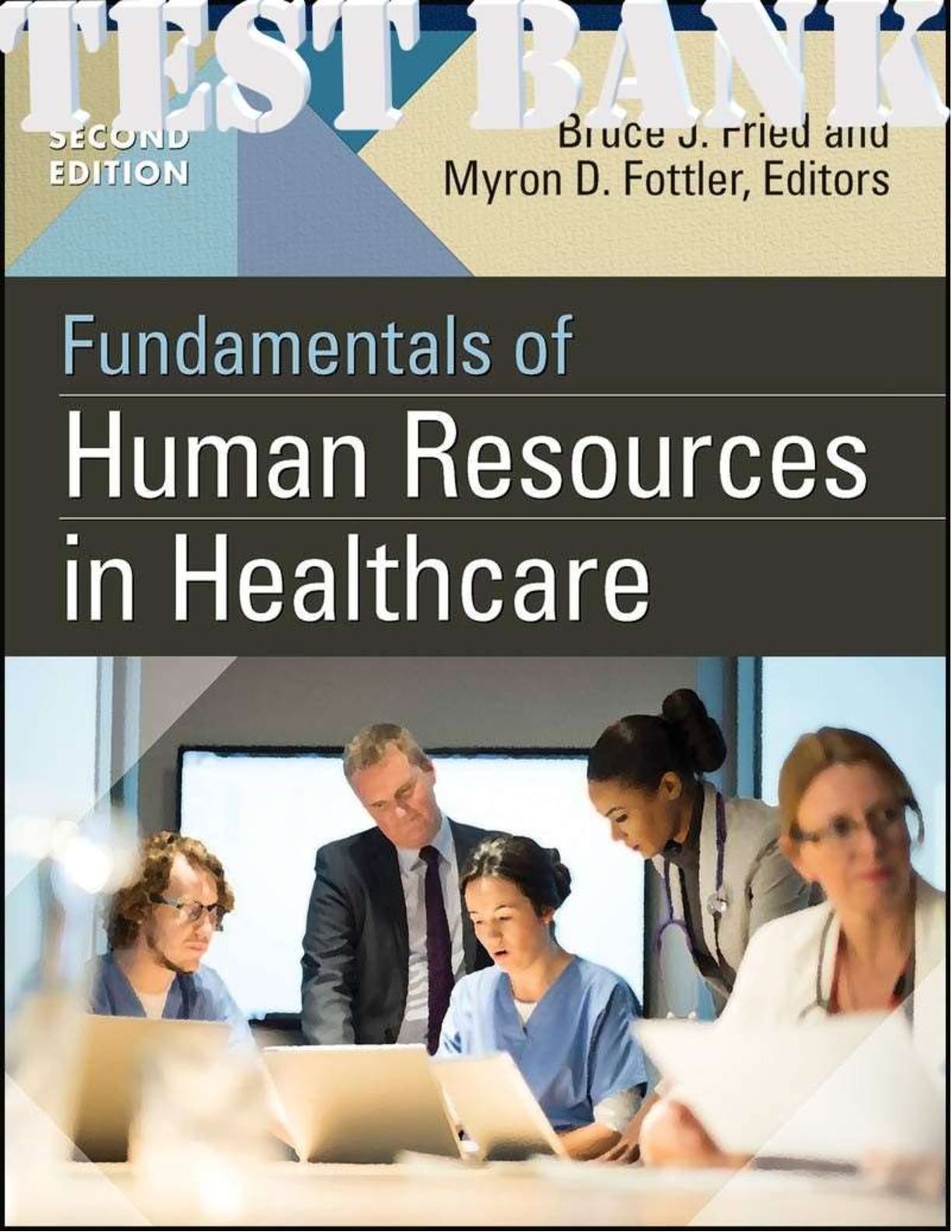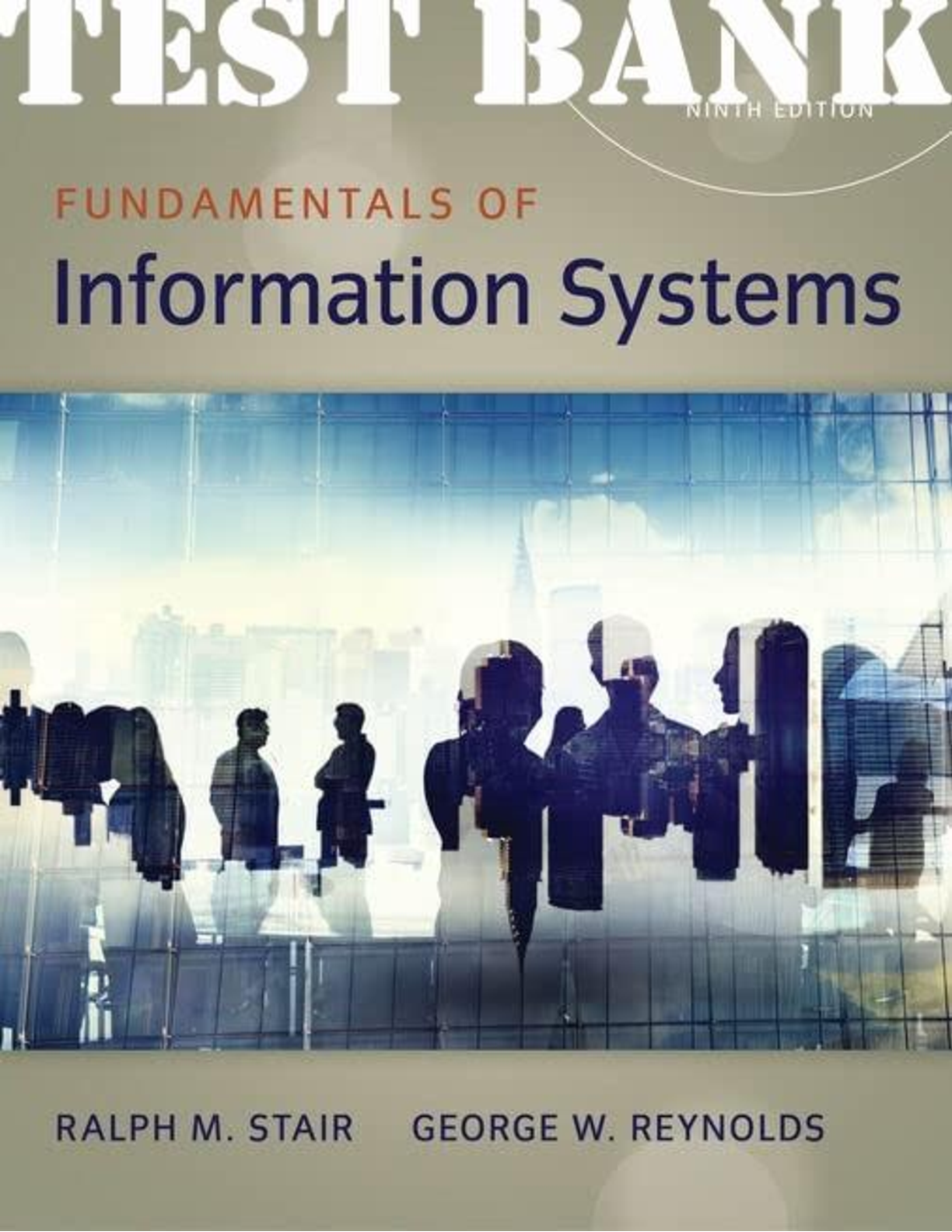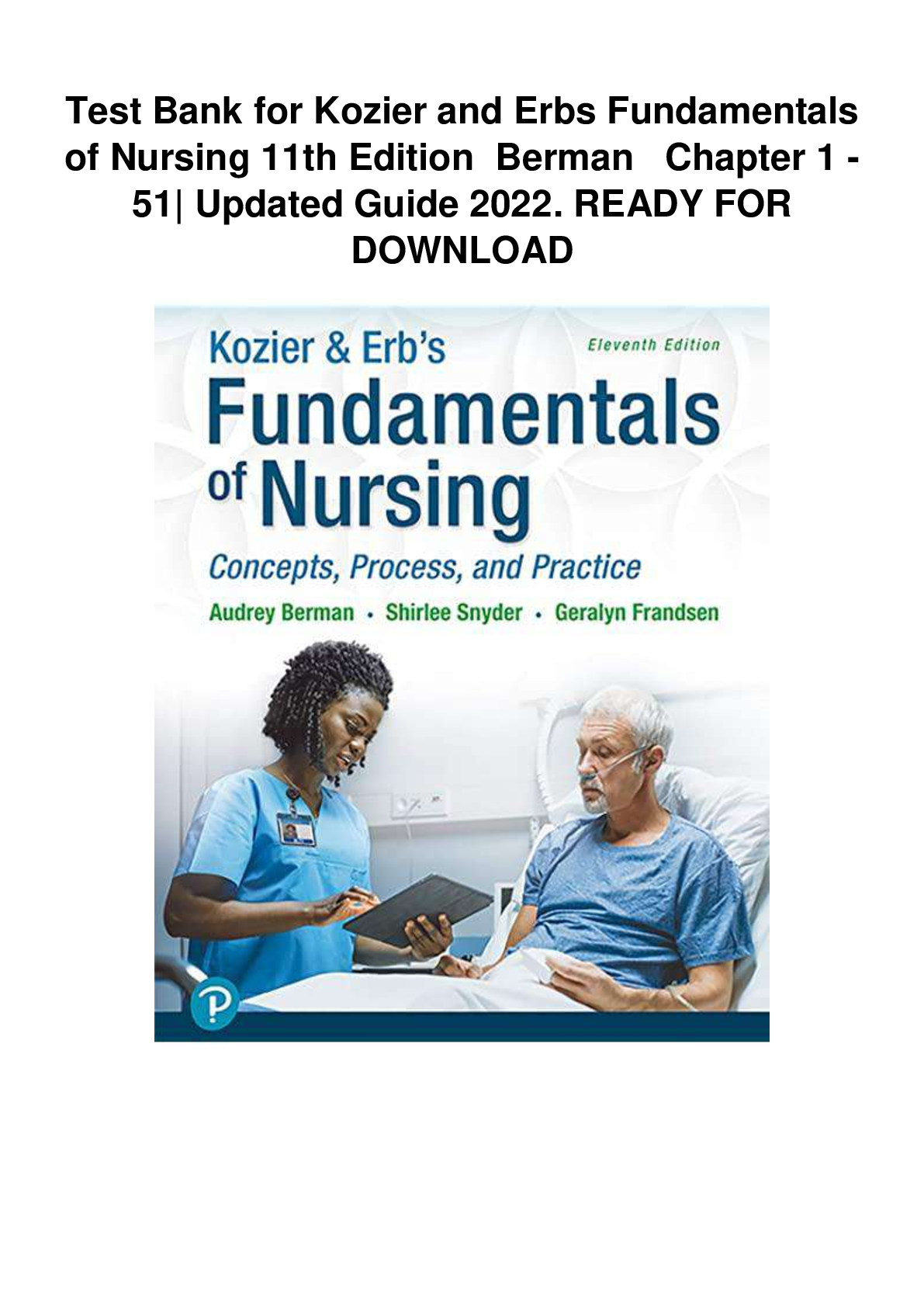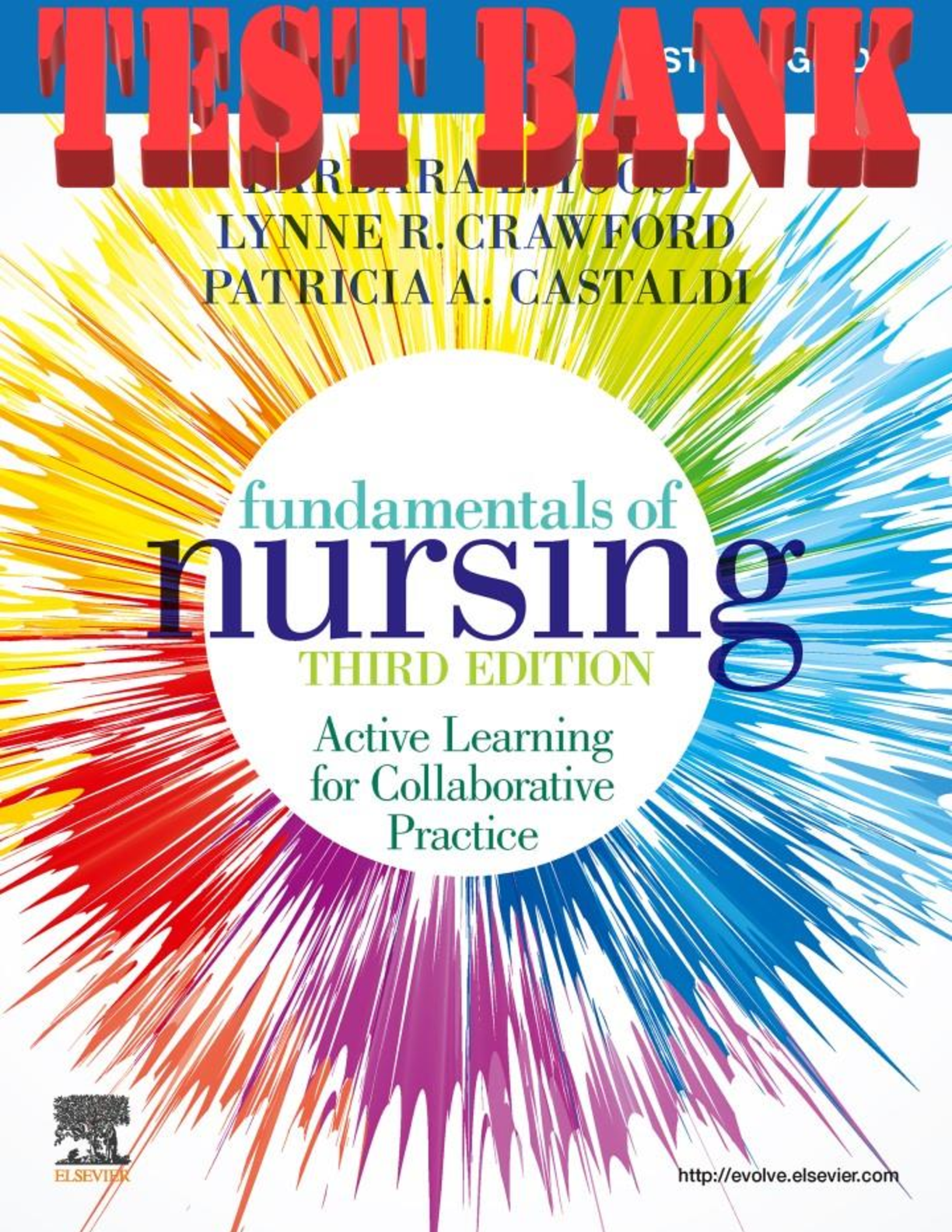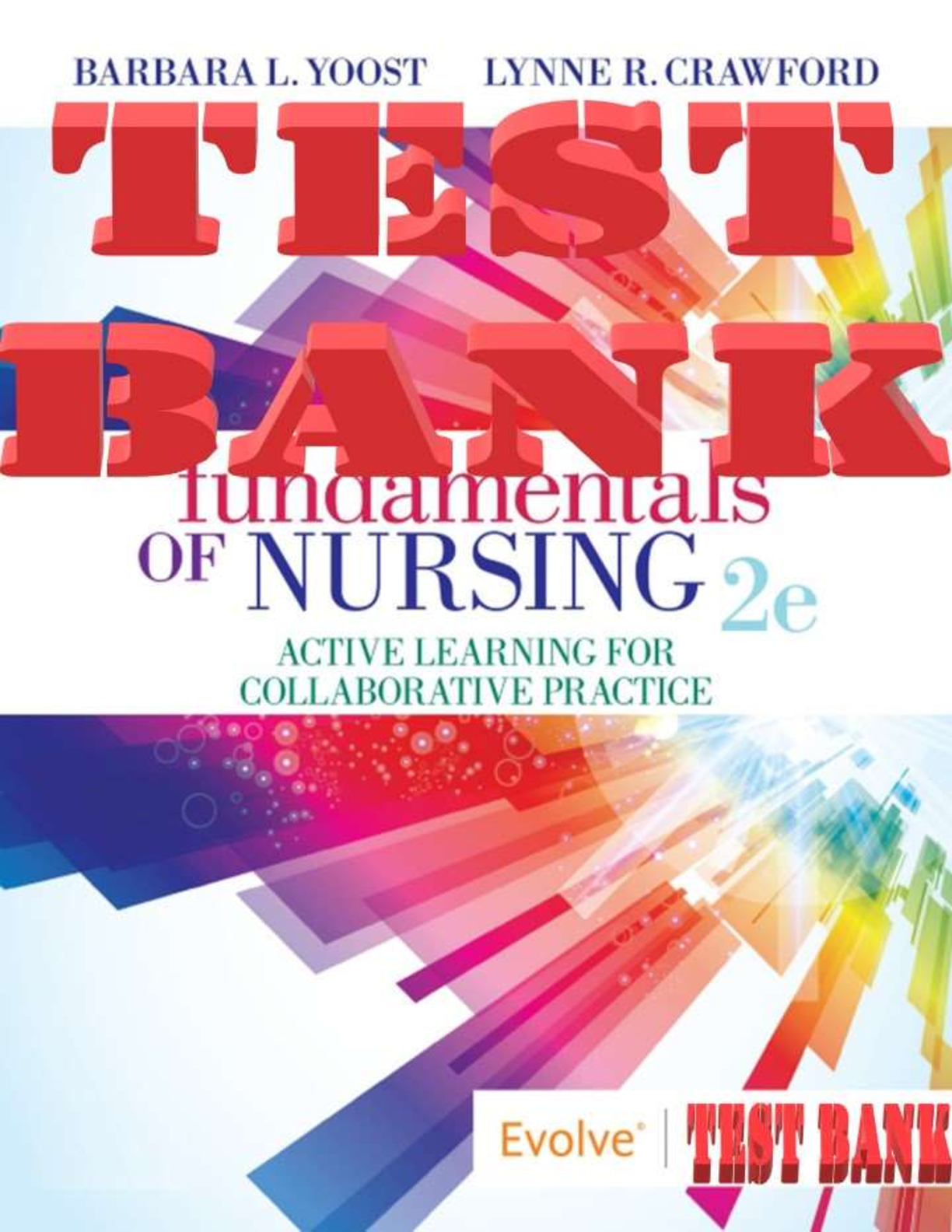*NURSING > TEST BANK > TEST BANK FOR FUNDAMENTALS OF NURSING 9TH EDITION BY TAYLOR / Mesa Community College - NURS 152 Fund (All)
TEST BANK FOR FUNDAMENTALS OF NURSING 9TH EDITION BY TAYLOR / Mesa Community College - NURS 152 Fundamentals of Nursing 9th Edition Taylor.
Document Content and Description Below
Chapter 1, Introduction to Nursing An oncology nurse with 15 years of experience, certification in the area of oncology nursing, and a master’s degree is considered to be an expert in her area of p... ractice and works on an oncology unit in a large teaching hospital. Based upon this description, which of the following career roles best describes this nurse’s role, taking into account her 1. qualifications and experience? A) Clinical nurse specialist B) Nurse entrepreneur C) Nurse practitioner D) Nurse educator Ans: A Feedback: A clinical nurse specialist is a nurse with an advanced degree, education, or experience who is considered to be an expert in a specialized area of nursing. The clinical nurse specialist carries out direct patient care; consultation; teaching of patients, families, and staff; and research. A nurse practitioner has an advanced degree and works in a variety of settings to deliver primary care. A nurse educator usually has an advanced degree and teaches in the educational or clinical setting. A nurse entrepreneur may manage a clinic or health-related business. What guidelines do nurses follow to identify the patient’s health care needs and strengths, to establish and carry out a 2. plan of care to meet those needs, and to evaluate the effectiveness of the plan to meet established outcomes? A) Nursing process B) ANA Standards of Professional PerformancNe C) Evidence-based practice guidelines D) Nurse Practice Acts Ans: A Feedback: The nursing process is one of the major guidelines for nursing practice. Nurses implement their roles through the nursing process. The nursing process is used by the nurse to identify the patient’s health care needs and strengths, to establish and carry out a plan of care to meet those needs, and to evaluate the effectiveness of the plan to meet established outcomes. Which of the following organizations is the best source of information when a nurse wishes to determine whether an 3. action is within the scope of nursing practice? A) American Nurses Association (ANA) B) American Association of Colleges in Nursing (AACN) C) National League for Nursing (NLN) D) International Council of Nurses (ICN) Ans: A Feedback: The ANA produces the 2003 Nursing: Scope and Standards of Practice, which defines the activities specific and unique to nursing. The AACN addresses educational standards, while the NLN promotes and fosters various aspects of nursing. The ICN provides a venue for national nursing organizations to collaborate, but does not define standards and scope of practice. 4. Who is considered to be the founder of professional nursing? A) Dorothea Dix B) Lillian Wald C) Florence Nightingale D) Clara Barton Ans: C Feedback: Florence Nightingale is considered to be the founder of professional nursing. She elevated the status of nursing to a respected occupation, improved the quality of nursing care, and founded modern nursing education. Although the other choices are women who were important to the development of nursing, none of them is considered the founder. 5. Which of the following nursing pioneers established the Red Cross in the United States in 1882? A) Florence Nightingale B) Clara Barton C) Dorothea Dix D) Jane Addams Ans: B N Feedback: Clara Barton volunteered to care for wounds and feed union soldiers during the civil war, served as the supervisor of nurses for the Army of the James, organized hospitals and nurses, and established the Red Cross in the United States in 1882. A nurse practitioner is caring for a couple who are the parents of an infant diagnosed with Down Syndrome. The nurse 6. makes referrals for a parent support group for the family. This is an example of which nursing role? A) Teacher/Educator B) Leader C) Counselor D) Collaborator Ans: C Feedback: Counseling skills involve the use of therapeutic interpersonal communication skills to provide information, make appropriate referrals, and facilitate the patient’s problem-solving and decision-making skills. The teacher/educator uses communication skills to assess, implement, and evaluate individualized teaching plans to meet learning needs of clients and their families. A leader displays an assertive, self-confident practice of nursing when providing care, effecting change, and functioning with groups. The collaborator uses skills in organization, communication, and advocacy to facilitate the functions of all members of the health care team as they provide patient care. A nurse is providing nursing care in a neighborhood clinic to single, pregnant teens. Which of the following actions is 7. the best example of using the counselor role as a nurse? A) Discussing the legal aspects of adoption for teens wishing to place their infants with a family B) Searching the Internet for information on child care for the teens who wish to return to school C) Conducting a client interview and documenting the information on the client’s chart D) Referring a teen who admits having suicidal thoughts to a mental health care specialist Ans: D Feedback: The role of the counselor includes making appropriate referrals. Discussing legal issues is the role of the advocate and searching for information on the Internet is the role of a researcher. Conducting a client interview would fall under the role of the caregiver. A nurse instructor explains the concept of health to her students. Which of the following statements accurately describes 8. this state of being? A) Health is a state of optimal functioning. B) Health is an absence of illness. C) Health is always an objective state. D) Health is not determined by the patient. Ans: A Feedback: Health is a state of optimal functioning or wNell-being. As defined by the World Health Organization, one’s health includes physical, social, and mental components and is not merely the absence of disease or infirmity. Health is often a subjective state; a person may be medically diagnosed with an illness but still consider himself or herself healthy. A nurse incorporates the health promotion guidelines established by the U.S. Department of Health document: Healthy 9. People 2010. Which of the following is a health indicator discussed in this document? A) Cancer B) Obesity C) Diabetes D) Hypertension Ans: B Feedback: The 10 leading indicators of health established by Healthy People 2010 are: physical activity, excessive weight and obesity, tobacco use, substance abuse, responsible sexual behavior, mental health, injury and violence, environmental quality, immunizations, and access to health care. 10. Which of the following is a criteria that defines nursing as profession? A) an undefined body of knowledge B) a dependence on the medical profession C) an ability to diagnose medical problems D) a strong service orientation Ans: D Feedback: Nursing is recognized increasingly as a profession based on the following defining criteria: well-defined body of specific and unique knowledge; strong service orientation; recognized authority by a professional group; code of ethics; professional organization that sets standards; ongoing research; and autonomy. After graduation from an accredited program in nursing and successfully passing the NCLEX, what gives the nurse a 11. legal right to practice? A) Enrolling in an advanced degree program B) Filing NCLEX results in the county of residence C) Being licensed by the State Board of Nursing D) Having a signed letter confirming graduation Ans: C Feedback: The Board of Nursing in each state has the legal authority to allow graduates of approved schools of nursing to take the licensing examination. Those who successfully meet the requirements for licensure are given a license to practice nursing in the state. It is illegal to practice nursing without a license issued by the State Board of Nursing. A nurse does not have the legal right to practice nursing by enrolling in an advanced degree program, filing NCLEX results, or having a letter confirming graduation. A health care facility determined that a nurse employed on a medical unit was documenting care that was not being given, and subsequently reported the action to the State Board of Nursing. How might this affect the nurse’s license to 12. practice nursing? N A) It will have no effect on the ability to practice nursing. B) The nurse can practice nursing at a less-skilled level. C) The nurse’s license may be revoked or suspended. D) The nurse’s license will permanently carry a felony conviction. Ans: C Feedback: The license and the right to practice nursing can be denied, revoked, or suspended for professional misconduct, such as a crime. Other areas of professional misconduct include incompetence, negligence, and chemical impairment. Committing a felony does affect the legal right to practice nursing, does not allow the nurse to practice at a lower level, and is not attached to the license. While providing care to the diabetic patient the nurse determines that the patient has a knowledge deficit regarding 13. insulin administration. This nursing action is described in which phase of the nursing process? A) evaluation B) implementation C) planning D) nursing diagnosis Ans: D Feedback: Nursing focuses on human responses to actual or potential health problems. Identifying the problems occur in the nursing diagnosis phase. Mutually establishing expected outcomes with the patient occurs in the planning phase. Implementation of the individualized interventions, and evaluation of outcomes are also phases in the nursing process. A nurse is caring for a client who is a chronic alcoholic. The nurse educates the client about the harmful effects of alcohol and educates the family on how to cope with the client and his alcohol addiction. Which of the following skills is 14. the nurse using? A) Caring B) Comforting C) Counseling D) Assessment Ans: C Feedback: The nurse is using counseling skills to educate the client about the harmful effects of alcohol. The nurse can also suggest rehabilitative care for the client. The nurse uses therapeutic communication techniques to encourage verbal expression and to understand the client’s perspective. Caring, comforting, and assessment may require active listening, but counseling is based upon the active listening and interaction between the client and the counselor. A nurse is caring for a client with quadriplegia who is fully conscious and able to communicate. What skills of the nurse 15. would be the most important for this client? A) Comforting N B) Assessment C) Counseling D) Caring Ans: D Feedback: The client needs assistance in performing activities of daily life. This would require implementation of caring skills from the nurse. Comforting, counseling, and assessment skills are also required, but the priority is the caring skill. Comforting skills involve providing safety and security to the client, whereas counseling skills are implemented while providing health education and emotional support. Assessment skills would be required when collecting data from the client. A nurse is assigned the care of a client who has been admitted to the health care facility with high fever. Which nursing 16. skill should be put into practice at the first contact with the client? A) Assessment B) Caring C) Comforting D) Counseling Ans: A Feedback: On admission of the client to a health care facility, the nurse would be required to conduct an initial assessment of the client. Therefore, the nurse would implement his or her nursing skills in this case. This can be done by interviewing, observing, and examining the client. Caring skills are put into practice once the nursing needs are determined. Comforting and counseling skills may not have a major role in assessing client problems. A nurse is caring for a client with a hernia. Which of the following statements should the nurse use while counseling the 17. client about his condition? A) “Open hernioplasty is the best surgery for you.” B) “Open and laparoscopic hernioplasty are available.” C) “You are not a suitable candidate for hernioplasty.” D) “I had a bad experience when I underwent hernioplasty.” Ans: B Feedback: A counselor should provide the client with unbiased information from which to choose. Therefore, the statement that “Open and laparoscopic hernioplasty are available” should be used by the nurse when counseling a client with hernia. The nurse should, however, refrain from giving a personal opinion, so it should not be mentioned which surgery is best for the client; likewise, the nurse should not bring up his or her own past experiences. By reserving personal opinions, a nurse promotes the right of every person to make his or her own decisions and choices on matters affecting health and illness care. Telling the client about his suitability to surgery or the best surgery for him may be biased from the experiences of the past. A registered nurse assigns the task of tracheostomy suctioning of a client to the LPN. The LPN informs the nurse that she has never done the procedure practically on a client. What should be the most appropriate response from the 18. registered nurse? N A) “You are through with your theory class, so you should know.” B) “Take the help of the nurse who knows to perform the procedure.” C) “Take the help of the procedure manual and act accordingly.” D) “I will help you in performing the procedure on the client.” Ans: D Feedback: Although the registered nurse has assigned the task to the LPN, the overall responsibility lies with the registered nurse. The registered nurse is answerable for the client’s care, not the LPN. Telling the LPN that she should know the procedure because it is taught in class is inappropriate; putting theory into application would require supervision. Asking the LPN to refer to the manual and perform the procedure is incorrect because the LPN may commit mistakes. The LPN is not confident about the procedure and therefore should not be asked to do the task alone or with another nurse who knows the procedure. A nurse at a health care facility provides information, assistance, and encouragement to clients during the various phases 19. of nursing care. In which of the following activities does the nurse use counseling skills? A) Educating a group of young girls about AIDS B) Telling a client to localize the pain in his abdomen C) Encouraging a client to walk without support D) Assisting a lactating mother in feeding her child Ans: A Feedback: The activity of educating a group of young girls about AIDS is based on the nurse using counseling skills. Telling a client to localize his pain is an assessment skill. Encouraging a client to walk without support can be both a comforting skill and a caring skill. Assisting a lactating mother in feeding her baby is an example of a caring skill. A student wants to join a nursing program that provides flexibility in working at both staff and managerial positions. 20. Which nursing program should the nurse suggest for this student? A) Hospital-based diplomas B) Baccalaureate nursing programs C) Associate degree programs D) Continuing nursing programs Ans: B Feedback: The student could opt for a baccalaureate nursing program. Baccalaureate-prepared nurses have the greatest flexibility in qualifying for nursing positions at both staff and managerial levels. Hospital-based diploma programs are three-year courses and provide maximum exposure to clinical nursing. Students becoming nurses through the associate degree program would not be expected to work in a management position. Continuing nursing programs are on-the-job educational programs. 21. Training schools for nurses were established in the United States after the Civil War. The standards of U.S. schools deviated from those of the Nightingale paradigm. Which of the following statements is true about U.S. training schools? N A) Training schools were affiliated with a few select hospitals. B) Training of nurses provided no financial advantages to the hospital. C) Training was formal, based on nursing care. D) Training schools eliminated the need to pay employees. Ans: D Feedback: Training schools in the U.S. profited by eliminating the need to pay employees because students worked without pay in return for training, which usually consisted of chores. U.S. training schools were established by any hospital; there was no formal training. Training was an outcome of work, which eliminated the need to pay employees. Nightingale training schools were affiliated with a few select hospitals, training of nurses provided no financial advantages to the hospital, and the training was formal, based on nursing care. A student has completed a nursing program accredited by the Commission on Collegiate Nursing Education. Which of 22. the following is true about the organization? A) It fosters continued improvement in nursing education programs. B) Accreditation is by governmental peer review process. C) It ensures the quality and integrity of diploma nursing programs. D) It uses state-recognized standards to evaluate the programs. Ans: A Feedback: The Commission on Collegiate Nursing Education fosters continued improvement in nursing education programs. Accreditation is by nongovernmental, peer review process. It ensures the quality and integrity of baccalaureate and graduate nursing programs, not diploma nursing programs. It uses nationally-recognized, not state-recognized, standards to evaluate the programs. A registered nurse adheres to the American Nurses Association’s standard of professional performance by engaging in 23. which of the following? A) Assessment B) Diagnosis C) Evaluation D) Collaboration Ans: D Feedback: Collaboration is designated in ANA’s standard of professional performance. Assessment, diagnosis, and evaluation are not designated in ANA’s standard of professional performance. They are professional nursing responsibilities designated in ANA’s standard of care list. During the clinical rotation, a nurse documents the vital signs of a client on the bedside chart. What role is the nurse 24. playing in such a situation? A) Decision maker B) Communicator N C) Coordinator D) Client advocate Ans: B Feedback: The nurse is providing, in written form, the client’s vital signs to the health care provider checking the bedside chart during his or her clinical rounds, so the nurse acts as a communicator. The nurse is not making any decisions here, so the role is not that of a decision maker. The nurse is not playing the role of a coordinator or a client advocate. When the nurse coordinates services offered by a variety of health care professionals, the nurse acts as a coordinator. As a client advocate, the nurse should protect the client, understanding the client’s needs and concerns. 25. A licensed practice nurse (LPN) is working as a staff nurse. What role do the LPNs working as staff nurses play? A) Work only in long-term care facilities and at client’s homes B) Provide direct nursing care to the clients in the health care facility C) Work only as care providers, team members, and communicators D) Supervise the work of charge nurses working in different units Ans: B Feedback: LPNs working as staff nurses provide direct nursing care to the clients in the health care facility. Staff nurses may work in hospitals, the community, clinics, long-term care facilities, or homes. They work not only as care providers, team members, and communicators but also as decision makers, client advocates, and educators. They do not supervise the work of charge nurses working in different units. Their work is coordinated by the charge nurse or the team leader. 26. The Nurse Corps of the United States Army was established by whom? A) Dorothea Dix B) Lillian Wald C) Florence Nightingale D) Isabel Hampton Robb Ans: A Feedback: Dorothea Dix established the Nurse Corps of the United States Army. The director of nursing (DON) of a major hospital is seeking to hire a nurse with a strong technical background to care 27. for patients on a busy surgical unit. The DON is most likely going to hire a nurse prepared at which level of nursing? A) Doctoral level B) Master’s level C) Baccalaureate level D) Associate level Ans: D N Feedback: The ANA’s 1965 resolution prompted the 1985 ANA statement adopting the titles of associate nurse (a nurse prepared in an associate degree program with an emphasis on technical practice) and professional nurse (a nurse possessing the baccalaureate degree in nursing) for these two levels. Master’s and doctoral prepared nurses possess higher degrees and expertise. A student is choosing her educational path and desires a nursing degree with a track that contains community nursing 28. and leadership, as well as liberal arts. The student would best be suited in which type of program? A) Licensed practical nursing program B) Certification in a nursing specialty C) Diploma nursing program D) Baccalaureate program Ans: D Feedback: The baccalaureate degree in nursing offers students a full college or university education with a background in the liberal arts. A nurse is caring for a young victim of a terrorist attack. During the rehabilitative process, the nurse assists the client in 29. bathing and dressing. What role the nurse is engaged in? A) Advocate B) Caregiver C) Counselor D) Educator Ans: B Feedback: As providers of care, nurses assume responsibility for helping clients promote, restore, and maintain health and wellness. Communicating the client’s needs and concerns, and protecting the client’s rights are components of the advocacy role of nursing. The nurse is simply assisting in hygiene measures; no education or counseling is being provided. A nurse receives an x-ray report on a newly admitted patient suspected of having a fractured tibia. The nurse contacts 30. the physician to report the findings. What role is the nurse engaged in? A) Communicator B) Advocate C) Caregiver D) Researcher Ans: A Feedback: Nurses are communicators when they report findings to the health care team. Advocacy involves actions such as protecting the patient’s safety or rights. Administering care measures directly to the patient demonstrates the caregiver role. Research involves collecting and analyzing data. 31. The client’s plan of care is created by the nNurse using which guideline for nursing practice? A) Nursing process B) Nursing’s Social Policy Statement C) Nurse practice act D) ANA Standards of Nursing Practice Ans: A Feedback: Nursing process is used by nurses to identify the client’s strengths, limitations, and health care needs; to formulate a plan of care to address the health care needs; to plan and implement a plan of care to meet those health care needs; and to evaluate the effectiveness of the plan to achieve established outcomes. The ANA Standards of Nursing Practice defines the activities of nurses that are specific and unique to nursing. Nurse practice acts are laws established by each state to regulate the practice of nursing. Nursing’s Social Policy Statement describes the values and social responsibility of nursing, provides a definition and scope of practice for nursing and nursing’s knowledge base, including the methods by which nursing is regulated. The nurse is administering immunizations to a group of teens in a county health clinic. The nurse correctly identifies this 32. action as: A) Illness prevention B) Restorative care C) Treatment of disease D) Supportive nursing care Ans: A Feedback: The aim of illness prevention activities is to reduce the risk for illness, to promote good health habits, and to maintain optimal functioning. Immunization administration is an example of illness prevention. Assisting with crutch walking, and teaching medication administration would be examples of health restoration activities. Administering antibiotics to a patient to treat an infection would be an example of treatment of disease. Hospice care is an example of supportive care. Which nursing role is the nurse exhibiting when collecting data about the number of urinary tract infections on the 33. nursing unit? A) Advocate B) Leader C) Counselor D) Researcher Ans: D Feedback: Data collection is part of the research process. As an advocate, the nurse would implement actions to protect the rights of the client. Counseling involves the use of therapeutic, interpersonal communication skills to provide information, make appropriate referrals, and facilitate client problem-solving and decision-making skills. A nurse leader is assertive and self-confident when providing care, effecting change, and functioning within groups. A client reports to the emergency department with ankle pain from a minor road accident. The nurse asks the client to fully describe the circumstances of the accident. Which ANA standard of nursing practice is best demonstrated by the 34. nurse’s action? N A) Assessment B) Diagnosis C) Ethics D) Caring Ans: A Feedback: According to the ANA Standard I, the registered nurse collects comprehensive data pertinent to the client’s health or the situation. Standard 2 – Diagnosis is Standard 2, which occurs when the registered nurse analyzes the assessment data to determine the diagnoses or issues pertaining to the client. Standard 7 – Ethics pertains to the ethical guidelines of nursing practice. Caring, although an essential part of nursing practice, is not considered an ANA Standard. Organize these events in chronological order, beginning with the earliest (1) and ending with the most recent (5). 1) During the Crusades, religious orders provided nursing care to the sick. 2) Florence Nightingale administered care to British soldiers during the Crimean War. 3) Clara Barton organized the American Red Cross. 4) Mary Elizabeth Mahoney graduated from the New England Hospital for Women and Children in 1879 as America’s first African American nurse. 35. 5) Margaret Sanger advocated for contraception and family planning in the United States. A) 1, 2, 3, 4, 5 B) 1, 2, 4, 3, 5 C) 1, 2, 4, 5, 3 D) 1, 2, 3, 5, 4 E) 2, 1, 4, 3, 5 Ans: A Feedback: The correct order of these events is (1) during the Crusades, religious orders provided nursing care to the sick; (2) Florence Nightingale administered care to British soldiers during the Crimean War; (3) Clara Barton organized the American Red Cross; (4) Mary Elizabeth Mahoney graduated from the New England Hospital for Women and Children in 1879 as America’s first African American nurse; and (5) Margaret Sanger advocated for contraception and family planning in the United States. Chapter 2, Theory, Research, and Evidence- Based Practice After reviewing several research articles, the clinical nurse specialist on a medical surgical unit rewrites the procedure 1. on assessing placement of a nasogastric tube. What source of nursing knowledge did the nurse use in this situation? A) Scientific knowledge N B) Traditional knowledge C) Authoritative knowledge D) Philosophical knowledge Ans: A Feedback: The clinical nurse specialist utilized scientific knowledge, which is gained through the research-based scientific method. Philosophical knowledge is not a source of nursing knowledge, but is a type of general knowledge. Authoritative knowledge comes from an expert and is accepted as truth based upon the person’s perceived expertise. Traditional knowledge is that part of nursing practice passed down from generation to generation and is not based upon scientific inquiry. Which of the following theories emphasizes the relationships between the whole and the parts, and describes how parts 2. function and behave? A) General systems theory B) Nursing theory C) Adaptation theory D) Developmental theory Ans: A Feedback: General systems theory describes how to break whole things into parts and then learn how the parts work together in “systems.” Nursing theory attempts to describe, explain, predict, and control desired outcomes of nursing care practices. Adaptation theory defines adaptation as the adjustment of living matter to other living things and to environmental conditions. Developmental theory outlines the process of growth and development of humans as orderly and predictable. A nurse researcher is studying perceptions of vocational rehabilitation for clients after a spinal cord injury. What type of 3. research method will be used to study the perceptions of this group of individuals? A) Qualitative research B) Quantitative research C) Basic research D) Applied research Ans: A Feedback: The nurse researcher will use qualitative research methods to investigate perceptions, and the researcher will analyze words instead of numbers, which are analyzed in quantitative research. Basic and applied research are quantitative research methods. A staff development nurse is asking a group of new staff nurses to read and be prepared to discuss a qualitative study that focuses on nursing events of the past. This is done in an attempt to increase understanding of the nursing profession 4. today. What method of qualitative research is used in this article? A) Historical B) Phenomenology N C) Grounded theory D) Ethnography Ans: A Feedback: This article uses historical methodology, which examines events of the past to increase understanding of the nursing profession today. Phenomenology is used to describe experiences as they are lived by the subjects being studied. Grounded theory is the discovery of how people describe their own reality and how their beliefs are related to their actions in a social scene. Ethnography is used to examine issues of a culture that are of interest to nursing. In understanding the historical influences on nursing knowledge, nursing as a profession struggled for years to establish 5. its own identify and to receive recognition for its contributions to health care. Why? A) The conceptual and theoretical basis for nursing practice came from outside the profession. B) Nurses were too busy working in practice to increase the public awareness associated with the role of the nurse. C) Nurses spent most of their time in laboratory settings conducting research. D) Women were independent and refused to work collectively. Ans: A Feedback: Despite Florence Nightingale’s belief in the uniqueness of nursing, the training of nurses was initially carried out under the direction and control of the medical profession. Because the conceptual and theoretical basis for nursing practice came from outside the profession, nursing struggled for years to establish its own identify and to receive recognition for its significant contributions to health care. An obstetrical nurse wishes to identify whether clients’ perceptions of a high level of support from their partner is associated with a decreased length of the second stage of labor. Which type of quantitative research is most appropriate 6. for this research question? A) Correlational research B) Descriptive research C) Quasi-experimental research D) Experimental research Ans: A Feedback: Correlational quantitative research is used to examine relationships between two or more variables. In this case, the variables are perceptions of partner support and length of Stage 2 labor. There is no manipulation of the variables as there would be in an experimental or quasi-experimental study. The focus on the relationship between the two variables goes beyond simple description of events. Nurse researchers have predicted that a newly created mentorship program will result in decreased absenteeism, increased retention, and decreased attrition among a hospital’s nursing staff. Which of the following does this predicted 7. relationship represent? A) Hypothesis B) Dependent variable N C) Abstract D) Methodology Ans: A Feedback: A hypothesis is an expected statement of the relationship between variables in a study. In this study, the dependent variables are absenteeism, retention, and attrition while the independent variable is the mentorship program. The methodology of a study is the logistical framework that guides the planning and execution of the study. An abstract is a summary of a research study published in a journal. 8. The practice of changing patients’ bedclothes each day in acute care settings is an example of what type of knowledge? A) Authoritative B) Traditional C) Scientific D) Applied Ans: B Feedback: Changing bedclothes daily in acute care settings is an example of traditional knowledge. The practice is not based on research findings, but is rather a part of nursing practice passed down from generation to generation. A student nurse learns how to give injections from the nurse manager. This is an example of the acquisition of what type 9. of knowledge? A) Authoritative B) Traditional C) Scientific D) Applied Ans: A Feedback: Authoritative knowledge comes from an expert and is accepted as truth, based on the person’s perceived expertise. Authoritative knowledge generally remains unchallenged as long as the presumed authority maintains his or her perceived expertise. A client undergoing chemotherapy for a brain tumor believes that having a good attitude will help in the healing process. 10. This is an example of what type of knowledge? A) Science B) Philosophy C) Process D) Virtue Ans: B N Feedback: Philosophy is the study of wisdom, fundamental knowledge, and the processes used to develop and construct one’s perceptions of life. Philosophy provides a viewpoint and implies a system of values and beliefs. Each individual develops a personal philosophy to give meaning to experiences and to guide behavior and attitudes. Personal philosophies are developed by learning from interpersonal relationships, through formal and informal educational experiences, through religion and culture, and from the environment. 11. Which of the following accurately describes Florence Nightingale’s influence on nursing knowledge? A) She defined nursing practice as the continuation of medical practice. B) She differentiated between health nursing and illness nursing. C) She established training for nurses under the direction of the medical profession. D) She established a theoretical base for nursing that originated outside the profession. Ans: B Feedback: Nightingale influenced nursing knowledge and practice by demonstrating efficient and knowledgeable nursing care, defining nursing practice as separate and distinct from medical practice, and differentiating between health nursing and illness nursing. During the first half of the 20th century, a change in the structure of society resulted in changed roles for women and, in 12. turn, for nursing. What was one of these changes? A) More women retired from the workforce to raise families. B) Women became more dependent and sought higher education. C) The focus of nursing changed to “hands-on training.” D) Nursing research was conducted and published. Ans: D Feedback: As a result of World Wars I and II, women increasingly entered the workforce, became more independent, and sought higher education. At the same time, nursing began to focus more on education than hands-on training, and nursing research was conducted and published. 13. A staff nurse asks a student, “Why in the world are you studying nursing theory?” How would the student best respond? A) “Our school requires we take it before we can graduate.” B) “We do it so we know more than your generation did.” C) “I think it explains how we should collaborate with others.” D) “It helps explain how nursing is different from medicine.” Ans: D Feedback: Nursing theory differentiates nursing from other disciplines and activities in that it serves the purpose of describing, explaining, predicting, and controlling desired outcomes of nursing care practices. 14. Why are the developmental theories importNant to nursing practice? A) They describe how parts work together as a system. B) They outline the process of human growth and development. C) They define human adaptation to others and to the environment. D) They explain the importance of legal and ethical care. Ans: B Feedback: Developmental theories outline the process of growth and development of humans as orderly and predictable, beginning with conception and ending with death. Nurses apply this knowledge to develop interventions for people across the life span. Systems theory, adaptation theories, and legal/ethical care are also important to nursing, but these do not explain the importance of human growth and development in nursing care. 15. There are four concepts common in all nursing theories. Which one of the four concepts is the focus of nursing? A) Person B) Environment C) Health D) Nursing Ans: A Feedback: The four concepts listed are all common in nursing theory, but the most important—and the focus of nursing—is the person (client). 16. What is the ultimate goal of expanding nursing knowledge through nursing research? A) Learn improved ways to promote and maintain health. B) Develop technology to provide hands-on nursing care. C) Apply knowledge to become independent practitioners. D) Become full-fledged partners with other care providers. Ans: A Feedback: The ultimate goal of expanding nursing’s body of knowledge through nursing research is to learn improved ways to promote and maintain health. Ongoing practice-based research reflects the nursing profession’s commitment to meet the ever-changing demands of health care consumers. While doing research also facilitates the development of technology, helps produce independent practitioners, and provides partnerships with other providers of care, those are not the ultimate goals of nursing research. What was significant about the promotion of the National Center for Nursing Research to the current National Institute 17. of Nursing Research (NINR)? A) Increased numbers of articles are published in research journals. B) NINR gained equal status with all other National Institutes of Health. C) NINR became the major research body of the International Council of Nurses. N D) It decreased emphasis on clinical research as an important area for nursing. Ans: B Feedback: The National Center for Nursing Research was promoted to the National Institute of Nursing Research (NINR) in 1993, gaining equal status with all other National Institutes of Health. 18. Which of the following is a responsibility of an institutional review board (IRB)? A) Secure informed consent for researchers B) Review written accuracy of research proposals C) Determine risk status of all studies D) Secure funding for institutional research Ans: C Feedback: Federal regulations require that institutions receiving federal funding, or conducting studies of drugs or medical devices regulated by the Food and Drug Administration establish IRBs. The IRB reviews all studies conducted in the institution to determine risk status and to ensure that ethical principles are followed. The IRB does not secure informed consent, review the accuracy of proposals, or secure funding. Before developing a procedure, a nurse reviews all current research-based literature on insertion of a nasogastric tube. 19. What type of nursing will be practiced based on this review? A) Institutional practice B) Authoritative nursing C) Evidence-based nursing D) Factual-based nursing Ans: C Feedback: Evidence-based nursing practice (EBNP) is the conscientious, explicit, and judicious use of research-based information in making decisions about the delivery of care. EBNP does not include institutional practice, authoritative nursing, or factual-based nursing. One step in implementing evidence-based practice is to ask a question about a clinical area of interest or an intervention. The most common method is the PICO format. Which of the following accurately defines the letters in the PICO 20. acronym? A) P = population B) I = institution C) C = compromise D) O = output Ans: A Feedback: N P = patient, population, or problem of interest, I = intervention of interest, C = comparison of interest, and O = outcome of interest The nurse understands that general systems theory has important implications in nursing. Which of the following is an 21. assumption of the general systems theory? A) Human systems are open and dynamic. B) All humans are born with instinctive needs. C) Human needs are motivational forces. D) People grow and change throughout their lives. Ans: A Feedback: General systems theory assumes that human systems are open and dynamic with implicit boundaries. Human needs theory assumes that all humans are born with instinctive needs and human needs are motivational forces. Change theory assumes that people grow and change throughout their lives. A nursing student is conducting a literature review via the Internet to identify a problem area that may be applicable in scope for nursing. When conducting the search, which of the following would be most important for the student to keep 22. in mind? A) The Internet should be the last resort for scientific literature review. B) Very few nursing sites are available through the Internet. C) Most websites that provide nursing information are reliable. D) MedLine is a reputable online database of nursing information. Ans: D Feedback: MedLine is a highly reputable online database of nursing information. The Internet is continuously growing as a resource for nursing research and has developed into a sophisticated tool for information retrieval, as well as research for the general public and for nursing and health professionals. Hundreds of sites are available through the World Wide Web. However, not all websites that provide nursing information are reliable. A group of students is reviewing information about evidence-based practice in preparation for an exam. The students demonstrate understanding of the information when they identify which of the following as associated with evidence- 23. based practice? A) It emphasizes personal experience over science. B) Clinical expertise is integrated with external evidence. C) It involves gaining solutions to problems. D) The purpose is to learn about a specific problem. Ans: B Feedback: Evidence-based practice (EBP) is an approach to health care that realizes that pathophysiologic reasoning and personal experience are necessary, but not sufficient for making decisions. Advocates argue that medical decisions should be based, as much as possible, on a firm foundation of high-grade scientific evidence, rather than on experience or opinion. Its practice involves integrating individual clinical expertise with the best available external evidence from systematic research. Nursing research aims to gain solNutions to problems, learn about a specific problem, or to understand a situation. A nurse researcher decides to conduct a qualitative research study. With which of the following would the researcher be 24. involved? A) Collection of numerical data B) Determination of cause and effect C) Controlling personal biases D) Real world data collection Ans: D Feedback: Qualitative research strives for an understanding of the whole and requires the researcher to become the instrument as data is collected in the real-world, naturalistic setting. Numerical data, cause and effect and control of personal bias are key aspects of quantitative research. 25. In what way can a nurse differentiate strong research from poor research? A) By conducting the research B) Through author dialogue C) By critiquing the study D) Through the nurse’s own informal investigation Ans: C Feedback: Nurses must have a working knowledge of research methods, and a beginning ability to read for application and to critique research. 26. Nursing research is linked most closely to what? A) Propositions B) Outcome measures C) Treatments D) Nursing process Ans: D Feedback: Many similarities are found between the formalized research process and the nursing process format that is an integral part of nursing education. 27. Which of the following research studies would be of most interest to a nurse manager? A) Sister Callista Roy’s theory on adaptation B) Patricia Benner’s From Novice to Expert C) Kleinpell and Ferrans’ older intensive-care clients N D) Madeleine Leininger’s transcultural nursing theory Ans: B Feedback: Research affects the clinical practice of nurses in all areas, particularly in relation to the goals of nursing. Benner’s research will assist a nurse manager to support all levels of his or her staff. 28. How are the first stages of the nursing process and nursing research linked? A) They will answer a posed question. B) Each begins with goal development. C) The nurse assesses problems initially. D) There is a period of evaluation. Ans: C Feedback: The first step for the practicing nurse is to assess a problem; for the researcher, the first step is to recognize the general problem area. A nursing instructor would like to study the effect peer tutoring has on student success. What is the independent 29. variable? A) Nursing student B) Nursing education C) Peer tutoring D) Student success Ans: C Feedback: The independent variable is the presumed cause or influence on the dependent variable. A nursing student has been asked to correlate her clinical experiences with two different theories of nursing. The student 30. will recognize that which of the following concepts are common to all theories of nursing? Select all that apply. A) The client B) The environment C) Illness D) Needs E) Nursing Ans: A, B, E Feedback: While nursing theories vary significantly in their conceptualizations, the elements that are common to all include the client (person), the environment, health, and nursing. The concepts of needs and illness are addressed by some theories but these are not explicitly defined by otherNtheories. 31. Which of the following are examples of characteristics of evidence-based practice? Select all that apply. A) It is a problem-solving approach. B) It uses the best evidence available. C) It is generally accepted in clinical practice. D) It is based on current institutional protocols. E) It blends the science and art of nursing. Ans: A, B, E Feedback: Evidence-based nursing is a problem-solving approach to making clinical decisions, using the best evidence available. EBP may meet resistance in clinical practice as a result of the nursing shortage, the acuity level of clients, nurse’s skill in reading and evaluating published research, and an organizational culture that does not support change. EBP blends both the science and the art of nursing so that the best client outcomes are achieved. EBP takes into consideration client preferences and values as well as the clinical experiences of the nurse. 32. Which of the following are characteristics of nursing theories? Select all that apply. A) They provide rational reasons for nursing interventions. B) They are based on descriptions of what nursing should be. C) They provide a knowledge base for appropriate nursing responses. D) They provide a base for discussion of nursing issues. E) They help resolve current nursing issues and establish trends. Ans: A, C, D, E Feedback: Nursing theory provides rational and knowledgeable reasons for nursing interventions, based on descriptions of what nursing is and what nurses do. Additionally, nursing theory gives nurses the knowledge base necessary for acting and responding appropriately in various situations. It also provides a base for discussion, and, ideally, helps resolve current nursing issues. Nursing theories should be simple and general; simple terminology and broadly applicable concepts ensure their usefulness in a wide variety of nursing practice situations. 33. Which of the following examples represents the type of knowledge known as process? Select all that apply. A) A nurse dispenses medications to clients. B) A nurse changes the linens on a client’s bed. C) A nurse studies a nursing journal article on infection control. D) A nurse consults an ethics committee regarding an ethical dilemma. E) A nurse believes in providing culturally competent nursing care. Ans: A, B Feedback: A process is a series of actions, changes, or functions intended to bring about a desired result. During a process, one takes systematic and continuous steps to mNeet a goal and uses both assessments and feedback to direct actions that meet the goal. Reading a nursing journal is considered science. Consulting an ethics committee and providing culturally competent nursing care is considered philosophy. Which qualitative research method is described as follows: to describe experiences as they are lived by the subjects 34. being studied? A) Historical B) Ethnography C) Grounded theory D) Phenomenology Ans: D Feedback: The purpose of phenomenology, which is both a philosophy and a research method, is to describe experiences as they are lived by the subjects being studied. Historical research examines events of the past to increase understanding of the nursing profession today. Ethnography is used to examine issues of a culture that are of interest to nursing. The basis of grounded theory methodology is the discovery of how people describe their own reality, and how their beliefs are related to their actions in a social scene. The nurse working in research correctly identifies which of the following to be mandatory for the ethical conduction of 35. research in a hospital setting? A) Clients must grant informed consent if they are to participate. B) All interventions must benefit all clients. C) The client must directly and personally benefit from the research. D) Descriptive studies are more ethical than experimental studies. Ans: A Feedback: Informed consent is an absolute prerequisite for clients who are asked to participate as subjects in a research study. Not all interventions will benefit all (or even any) clients. The risks and benefits of research are considered carefully in light of ethical principles, but this does not necessarily mean that every participant in a study stands to benefit from it. Ethical standards are applicable and achievable in every type of research, and descriptive studies are not necessarily more [Show More]
Last updated: 1 year ago
Preview 1 out of 489 pages
Instant download

Buy this document to get the full access instantly
Instant Download Access after purchase
Add to cartInstant download
Reviews( 0 )
Document information
Connected school, study & course
About the document
Uploaded On
Jan 15, 2021
Number of pages
489
Written in
Additional information
This document has been written for:
Uploaded
Jan 15, 2021
Downloads
0
Views
98


